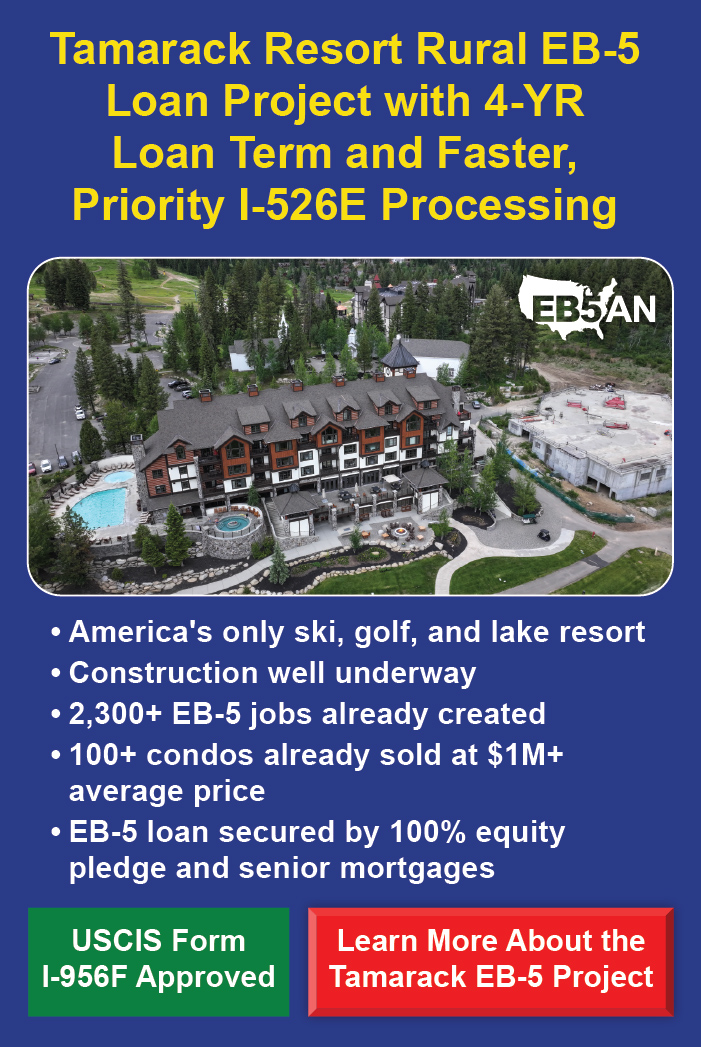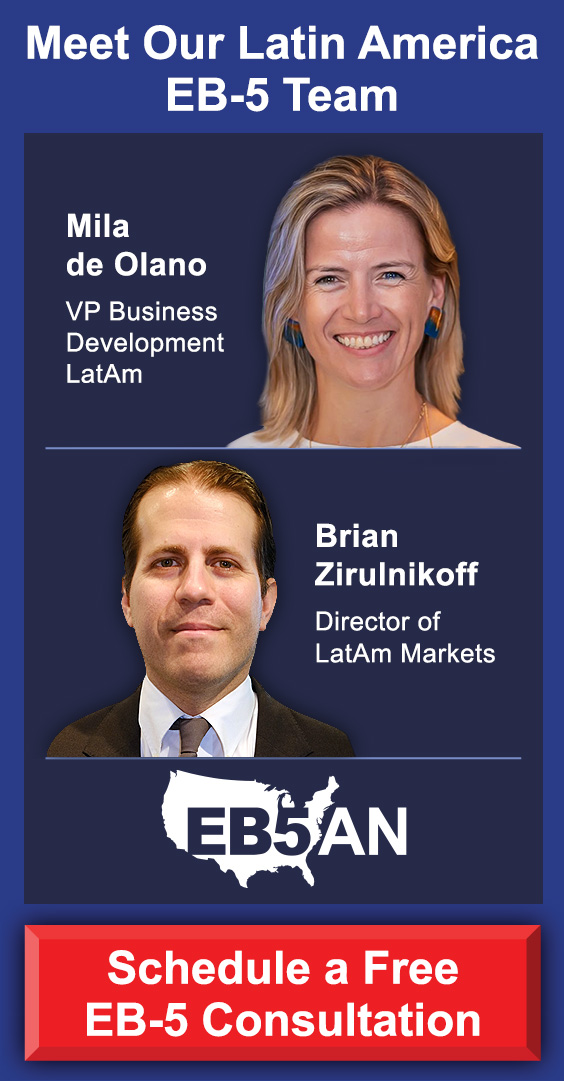Permanent Resident and Temporary Resident Statuses: EB-5 and E-2 Investment Visas
The EB-5 immigrant investor visa and the E-2 treaty investor visa are two types of visas offered to foreign nationals who wish to obtain residency in the United States for the purpose of employment or just as a place to live.
As there are several differences between the two visas; it is important for interested investors to have information about both types in order to select the visa that is best for them.
What Is an EB-5 Visa?
How Do I Get an EB-5 Visa?
How Much Does It Cost to Get an EB-5 Visa?
What Are the Requirements for Setting Up an EB-5 Project?
What Is an EB-2 Visa?
How Do I Get an EB-2 Visa?
What Can I Expect from My EB-2 Interview?
Do You Need to Use a Lawyer When Applying for an EB-2 or EB-5 Visa?
A Comparison Summary of the EB-5 and EB-2 Visas
What Is an EB-5 Visa?
An EB-5 visa, or Employment-Based Fifth Preference Visa, is part of a United States immigrant visa program that provides a pathway for foreign investors and their immediate family members to obtain U.S. permanent residency, also known as a Green Card.
The EB-5 program was created by the U.S. government in 1990 to stimulate the U.S. economy through job creation and capital investment.
To be eligible for the EB-5 visa, foreign investors must make a qualifying investment in a new commercial enterprise in the United States.
The minimum required investment amount is generally $1,050,000, but this amount can be reduced to $800,000 in targeted employment areas (TEAs) designated as high unemployment or rural.
EB-5 investors must create or preserve at least 10 full-time jobs for qualifying U.S. workers within two years of their admission to the United States as a conditional permanent resident.
These jobs can include direct jobs within the commercial enterprise or indirect jobs created through the economic impact of the investment.
Initially, successful EB-5 applicants are granted conditional permanent residency for a two-year period.
During this period, they enjoy the same rights and privileges than other U.S. permanent residents.
To remove the conditions and obtain permanent residency, investors must file a petition to demonstrate that they have met the investment and job creation requirements.
Once the conditions are removed, EB-5 investors and their immediate family members (spouse and unmarried children under 21 years old) become unconditional permanent residents of the United States.
They can live, work, study, or start businesses anywhere in the country, and they have the option to pursue U.S. citizenship after meeting the eligibility requirements.
Many EB-5 investments are made through designated regional centers, which are private or public entities that promote economic growth in specific geographic areas.
Regional centers can offer investors certain advantages, such as the ability to count indirect job creation toward the job creation requirement.
Why Do I Need An EB-5 visa?
If you are looking to relocate to the United States, the EB-5 visa may be a good option for you as it is one of the quickest ways to obtain your U.S. Green Card.
Here are some specific reasons you may want to investigate the EB-5 visa as a route to obtaining your Green Card:
Permanent residency in the United States
The EB-5 visa offers a direct path to obtaining permanent residency (a Green Card) in the United States. This allows you and your immediate family members (spouse and unmarried children under 21 years old) to live, work, study, and enjoy the benefits of being a permanent resident in the United States.
Business and investment opportunities
Through the EB-5 program, you have the opportunity to invest in a new commercial enterprise in the United States.
Education and healthcare benefits
Permanent residents in the United States have access to the U.S. education system, including public schools and universities. This is often offered at lower tuition rates compared to those of international students. They also gain access to health care and social benefits available to residents.
Access to the U.S. job market
As a permanent resident, you have the right to work in the United States without needing a separate work visa or sponsorship.
You can explore employment opportunities and pursue any career in the U.S. job market.
Potential path to U.S. citizenship
After having maintained permanent residency for a certain period of time, typically five years, you may be eligible to apply for U.S. citizenship if you meet the necessary requirements.
U.S. citizenship grants additional rights and benefits, including the ability to vote and hold certain government positions.
Here is a general overview of the process:
How Do I Get an EB-5 Visa?
Obtaining an EB-5 visa involves several steps and requirements. It is a significant help to consult with an experienced immigration attorney who specializes in the EB-5 program.
They will be able to guide you through the EB-5 application process and manage the actual preparation of your application.
1. Ensure that you are eligible for EB-5
Eligibility includes having the required minimum investment amount ($800,000) and demonstrating the lawful source of investment funds.
Additionally, you should be able to prove that your investment will create or preserve at least 10 full-time jobs for qualifying U.S. workers.
2. Select a regional center project
Select a suitable investment project for your EB-5 application.
You can either invest directly in a new commercial enterprise or choose to invest through a designated regional center. Regional centers are entities approved by U.S. Citizenship and Immigration Services (USCIS) to promote economic growth in specific areas.
Regional center projects generally offer a higher level of safety and are the preferred option for most EB-5 investors
3. File an I-526E Petition
The I-526E petition requires comprehensive documentation that proves your eligibility, such as evidence of your investment funds, business plan, job creation projections, and other supporting materials.
Upon approval of the I-526E petition, you will become a conditional permanent resident.
4. Consular processing or adjustment of status
If you are already in the United States with nonimmigrant status, you can apply for adjustment of status to become a conditional permanent resident.
If you are outside the United States, you need to go through consular processing at a U.S. embassy or consulate to obtain an immigrant visa.
5. Conditional permanent residency
Once approved, you will receive a conditional Green Card valid for two years.
During this conditional period, you must fulfill the job creation requirement and maintain your investment.
6. Removal of conditions
Before the expiration of the two-year conditional period, you must file an I-829 petition to remove the conditions on your permanent residency.
This petition requires evidence that you have met the investment and job creation requirements. If approved, the conditions will be removed, and you will receive a permanent Green Card valid for 10 years.
How Much Does It Cost to Get an EB-5 Visa?
You will be required to pay a few filing fees in order to apply for your EB-5 visa.
These include:
- Form I-526E filing fee: $3,675 (and an additional $1,000 for the EB-5 Integrity Fund)
- Form I-485 filing fee: $1,125
- Form I-829 filing fee: $3,750
There may be additional fees that you need to consider, such as translation fees, travel expenses, consultation fees, and legal fees.
These fees all vary, but your EB-5 visa attorney will be able to provide insight into how much you are likely to require to cover all the expenses related to obtaining your EB-5 visa.
What Are the Requirements for Setting Up an EB-5 Project?
EB-5 capital is becoming an increasingly popular source of funding for real estate developers.
The EB-5 project must involve the creation of a new commercial enterprise. This can either be a newly formed business entity such as a close corporation, partnership of limited liability company (LLC), or the reorganization or expansion of an existing organization that results in a new commercial entity.
The project will need to create at least 10 full-time jobs for qualifying U.S. workers within two years of the foreign investors’ admission as a conditional permanent resident.
In addition to the investment amount of $1,050,000, or $800,000 if the project is located in a TEA with high unemployment, the investor will need to prove that the funds come from a lawful source.
Investors will need to provide evidence of the legal origin of their investment capital, including personal financial records, tax returns, business ownership documents, and other supporting information.
If the project operates under a designated regional center, it will need to comply with the requirements that have been set out by the regional center program.
EB-5 projects also often involve securities offerings, and compliance with federal and state securities laws is essential.
All EB-5 regional center applications will require the following documents:
- Operational business plan.
- Corporate structure agreement.
- Sample project business plan.
- Economic report for the project.
- Legal securities documents.
- Legal immigration documents.
- Sample management agreement between regional center and project.
What Is an EB-2 Visa?
The EB-2 visa is an employment-based immigrant visa in the United States that has been designed for professionals with an advanced degree or for individuals with exceptional ability.
This visa will allow a foreign national to obtain permanent residency, which is also known as a Green Card, based on their qualifications and their employment prospects in the U.S.
Before applying for an EB-2 visa, the employer must generally obtain a permanent labor certification from the U.S. Department of Labor.
This certification confirms that there are no qualified U.S. workers available for the job being offered to a foreign national.
Under certain circumstances, individuals with exceptional ability may qualify for a national interest waiver which will allow them to bypass the labor certification process.
To qualify for this, they must be able to demonstrate that their work will be in the national interest of the U.S.
How Do I Get an EB-2 Visa?
To obtain an EB-2 visa, as an alien worker, you will be required to go through a few steps. These include:
Step 1: Employer sponsorship
It will be essential to secure a job offer from a U.S. employer who is willing to sponsor your EB-2 visa. The employer will need to prove that they have been unable to find a similarly-qualified U.S. worker for the role that you will be filling.
Step 2: Labor certification
Your new employer will need to obtain a labor certification from the U.S. Department of Labor (DOL). The labor certification proves that there are no U.S. citizens able to fulfill the needs of the role that you are applying for, and that your specific skills are not available in the U.S.
Step 3: I-140 Petition
Once the labor certification has been approved, your employer will need to file a Form I-140 petition on your behalf with USCIS. This petition confirms your eligibility for the EB-2 visa category.
Step 4: Priority date
The priority date is the date when Form I-140 is filed with USCIS. This is used to determine your place in the visa queue. EB-2 visas are subject to annual limits. The availability of an EB-2 visa depends on your priority date and the country of chargeability.
Step 5: Visa Bulletin
The U.S. Department of State publishes a monthly Visa Bulletin that provides information on visa availability for different categories, including the EB-2 category.
You need to monitor the Visa Bulletin to see when your priority date becomes current, indicating that a visa is available for you.
Step 6: Adjustment of status or consular processing
If you are already in the United States with valid nonimmigrant status, you may be able to file for adjustment of status by submitting Form I-485 to USCIS.
If you are still living outside the United States, you will need to go through consular processing at a U.S. embassy or consulate to obtain your immigrant visa.
Step 7: Visa interview and approval
If you are going through consular processing, you will attend an interview at the U.S. embassy or consulate.
The consular officer will review your application, conduct the interview, and make a decision on your visa application.
If approved, you will receive an immigrant visa, which allows you to enter the United States as a permanent resident.
What Can I Expect from My EB-2 Interview?
If you are applying for an EB-2 visa through U.S. consular processing, you may be required to attend an interview at a U.S. embassy or consulate.
The purpose of this interview is for the consular officer to review your application, ask you questions, and make a decision regarding your visa eligibility.
You can expect the following process when it comes to your EB-2 interview:
Consular appointment and documentation
You will receive an appointment notice which will specify the date, time, and location of your interview.
You will need to bring along the required documents, which will include your:
- Passport.
- Visa application confirmation page.
- Form DS-260.
- Additional documents the embassy or consulate has specifically asked you for.
The interview
Your consular officer will conduct the interview and may ask you questions about your background, qualifications, employment offer, and your intentions in the United States.
The officer’s goal is to assess your eligibility for the EB-2 visa and ensure that you meet the requirements.
Supporting documentation you may need
The consular officer may review the supporting documents that you’ve submitted with your application.
These may include educational degrees, work experience letters, job offer letters, financial documents, and any other relevant evidence to support your qualifications and the job offer.
English language proficiency
You may need to demonstrate your English language proficiency during the interview. The consular officer may ask you questions in English to assess your ability to communicate effectively.
Visa decision
At the end of the interview, the consular officer will inform you of their decision regarding your visa application.
If your visa is approved, you will receive an immigrant visa stamp in your passport, which allows you to enter the United States under lawful permanent resident status.
How much does it cost to get an EB-2 visa
There are different costs associated with obtaining your EB-2 visa. These costs can vary from person to person, based on their individual circumstances and needs.
Some of the costs that you can expect to budget for, include:
U.S. government filing fees
The U.S. government charges various filing fees for the EB-2 visa process.
These fees are subject to change; however, USCIS is able to provide the most up-to-date fee information.
- Form I-140 (Immigrant Petition for Alien Worker): $700
- Form DS-260 (Online Immigrant Visa Application): $325
- Form I-485 (Application to Register Permanent Residence or Adjust Status): $1,125
Medical examination
As part of the EB-2 visa process, you may need to undergo a medical examination with a physician designated by USCIS to ensure that you meet the health requirements.
The cost of the medical examination will vary depending on the location and the specific physician’s fees.
Supporting documentation
There may be costs associated with obtaining the necessary supporting documents for your EB-2 visa application, such as educational transcripts, work experience letters, and translations of documents not in English.
These costs will depend on the specific documents needed and the processes involved in obtaining them.
Do You Need to Use a Lawyer When Applying for an EB-2 or EB-5 Visa?
Although it is not legally required to use an attorney when applying for an EB-2 or EB-5 visa, it is preferable to seek the assistance of an experienced immigration attorney.
The application process for both the EB-2 and EB-5 visas involves navigating complex legal requirements, understanding the nuances of immigration law, and preparing extensive documentation.
An immigration attorney has the knowledge and expertise to guide you through the process, ensuring that all the necessary forms are correctly completed and submitted on time.
An immigration attorney can assess your eligibility for the EB-2 or EB-5 visa, review your qualifications, and help you determine the best course of action.
They have the knowledge to provide legal advice and develop a personalized strategy tailored to your specific circumstances. This will increase your chances of a successful application outcome.
Applying for an EB-2 or EB-5 visa requires submitting a substantial amount of supporting documentation.
An attorney can assist you in gathering the required documents, reviewing them for accuracy and completeness, and ensuring they meet the specific requirements of the visa category.
Immigration laws and regulations are subject to frequent changes and updates.
An immigration attorney will remain informed about the latest developments and can help you navigate any changes that may affect your visa application.
They will ensure that your application is compliant with all applicable laws and regulations, which reduces the risk of errors or omissions that could result in a denial.
An immigration attorney will act as your representative and communicate with government agencies on your behalf.
They can handle any requests for additional information, address any issues that arise during the process, and advocate for your interests throughout the application procedure.
Although hiring an immigration attorney involves additional costs, the benefits they provide can outweigh the expenses.
They can save you time, help you avoid mistakes, and increase the likelihood of a favorable outcome.
A Comparison Summary of the EB-5 and EB-2 Visas
While the EB-2 and EB-5 visas are both employment-based immigrant visas in the United States, they each have different eligibility criteria and purposes:
| Comparison | EB-5 Visa | EB-2 Visa |
|---|---|---|
| Resident status | EB-5 grants permanent residency (a Green Card), with the option of eventual citizenship. | EB-2 grants only temporary residency for a period of two years, although unlimited extensions can be obtained. |
| Extension of status | EB-5 immigration visas are also available to immediate family members (spouse and children under 21). | EB-2 visas are available to immediate family members, as well as employees and their immediate family members. |
| Job creation requirement | The investment in the EB-5 program must create at least 10 new full-time jobs to be eligible. | There is no requirement in the EB-2 program for the individual to create jobs. |
| 10 new full-time jobs to be eligible. |
As highly experienced EB-5 industry leaders, we are able to assist you with navigating the immigrant visa application process as quickly and efficiently as possible.
If you would like to start the visa application process, schedule a free consultation with EB5AN.







